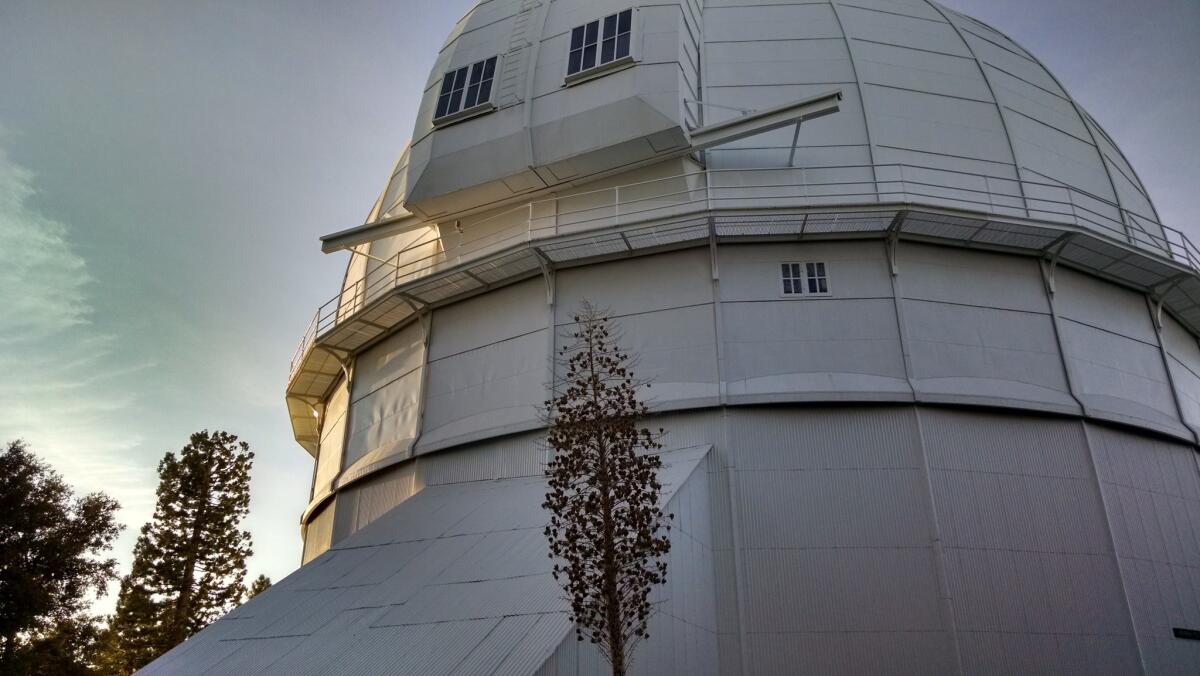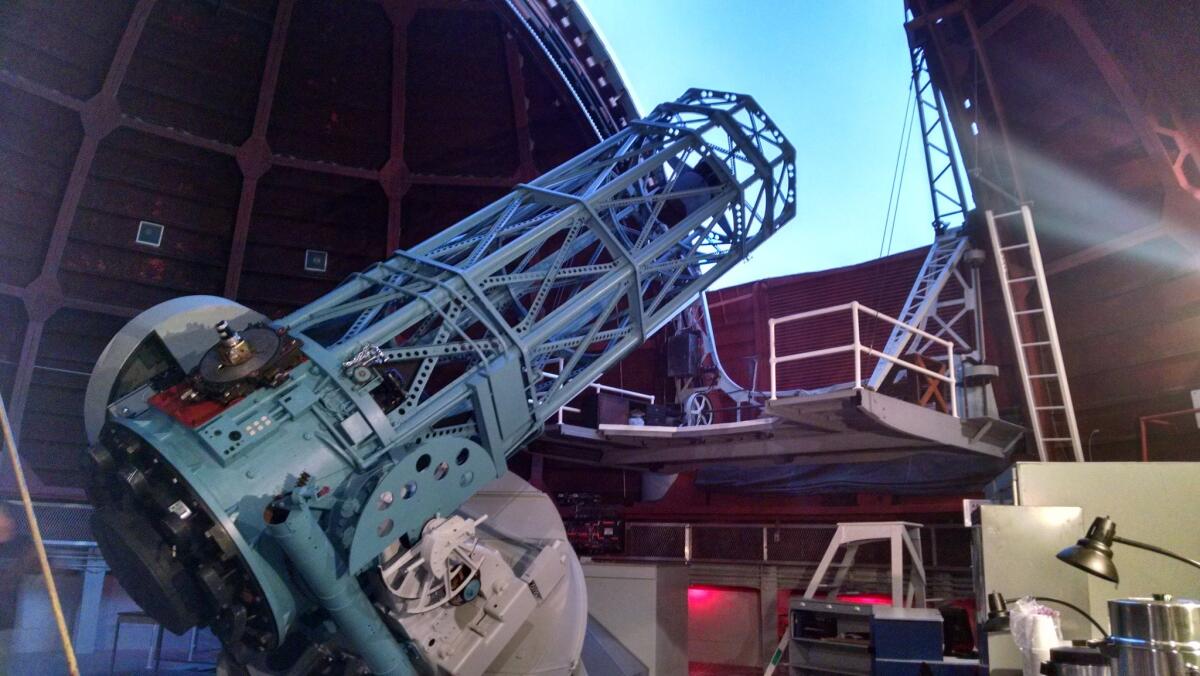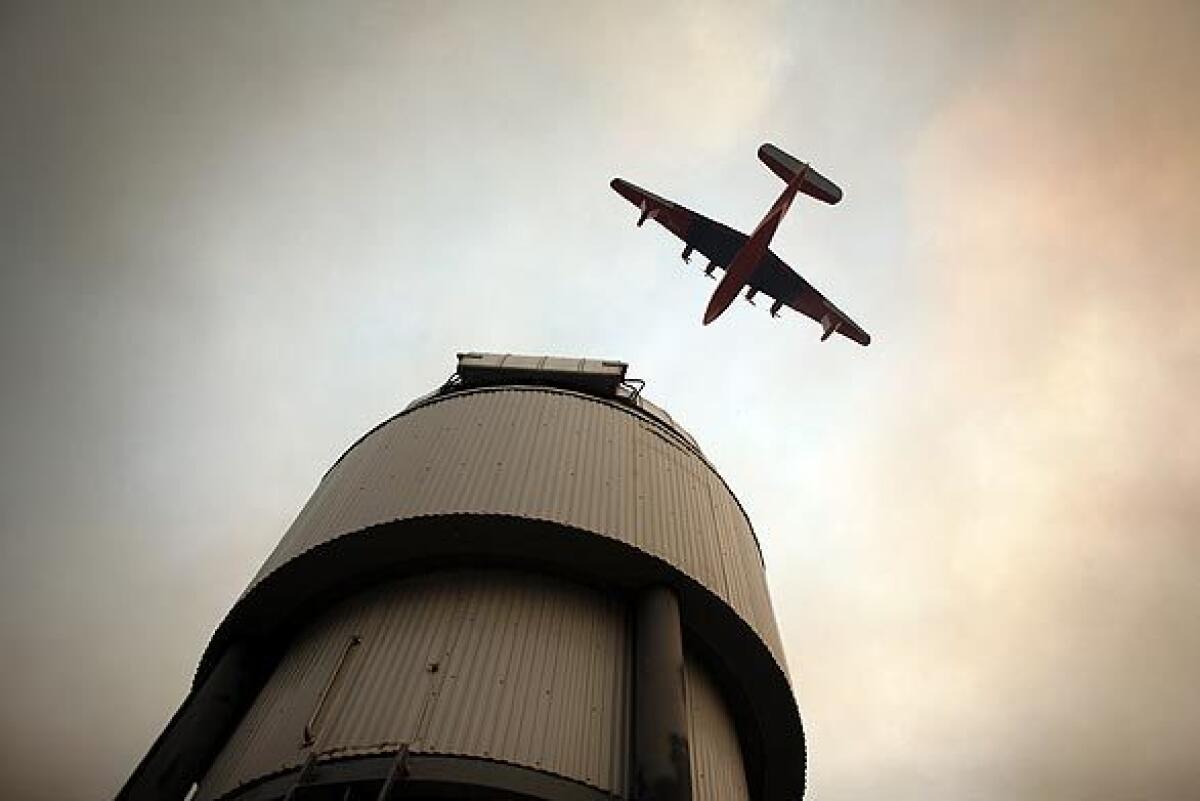So much at stake as firefighters battle to save historic Mt. Wilson Observatory
- Share via
Few places have played a more important role in the history of astronomy than the Mt. Wilson Observatory.
On Tuesday, that history was in jeopardy as the Bobcat fire moved perilously close to its famed telescope.
The Bobcat fire was within 500 feet of the observatory shortly after noon Tuesday, according to Angeles National Forest officials.
The historic observatory has been threatened for days by the growing fire, which ignited Sept. 6 in the Angeles National Forest. But fire officials are at the site and say they have a plan to defend it.
“They are in a firefight right now, because it is so close,” L.A. County Fire Capt. David Dantic said of crews positioned at Mt. Wilson.
Here is what we know from reports and past reporting in the Times:

The threat
The fire has been burning closer and closer to the observatory for days.
Mt. Wilson officials tweeted Monday night that it was “knocking on our door,” noting that all observatory personnel had been evacuated.
David Cendejas, superintendent of the complex that houses 18 astronomical wonders, including the 100-inch Hooker telescope, said Monday that firefighters were on hand, ready to do battle with the monster fire, which has swelled to more than 41,000 acres.
More than three dozen firefighters are now familiar with emergency firefighting systems and backup electric generators strategically located across the property, which is perched on a 5,710-foot mountain shaded by pine and oak trees.
Those systems include a water tank connected to a high-pressure pump built in 1970 and last used when the observatory was rescued from the snarling flames of the Station fire in 2009 after a firefight that lasted five days and four nights. The Station fire posed a major threat to the observatory, but it survived.
In 2017, a much smaller brush fire threatened to damage the mountaintop observatory and an array of television broadcast towers, prompting evacuations.
The Los Angeles County Fire Department was prepping for the worst Monday night.
“We’re not going anywhere,” Capt. Keith Stires said.
On Tuesday morning, L.A. County Fire Capt. Dantic said he hoped crews could keep the observatory complex safe.
“With cooperation and with the weather today — and in conjunction with water drops and hand crews putting containment lines down with the bulldozer — hopefully we can get better containment of the fire today,” he said.

The history
An important piece of history is at stake.
Mt. Wilson is a major site in the development of astronomy. The observatory was founded by George Ellery Hale in 1904, and its first telescopes — weighing hundreds of pounds each — were transported in pieces up the 9-mile Mt. Wilson toll road on the backs of burros. Now, the observatory lets visitors view space through its 60-inch telescope, which has been in place since 1908.
When the 100-inch Hooker telescope gathered its first light on Nov. 1, 1917, it overtook its 60-inch neighbor and became the largest telescope in the world — a position it held for more than three decades.
“In some ways, I consider Mt. Wilson Observatory to be the most important optical observatory in the history of astronomy,” Alex Filippenko, a UC Berkeley astronomer, told The Times in a 2017 article celebrating the telescope’s centennial.

Other observatories — in the high plains of Chile, in orbit around the Earth — have rendered Mt. Wilson obsolete, but the campus is still a destination for astronomers and stargazers, who for decades have been drawn by its famed “seeing,” a shared term of appreciation for the quality of light that defines Los Angeles.
The air from the Pacific Ocean, having flowed smoothly over the Los Angeles Basin, rises undisturbed and unruffled over the mountains. Stars don’t twinkle here, they glow.
The place is steeped in history. Hale, the learned astronomer who believed that from this vantage above L.A., the mysteries of the sun could be revealed, built three solar telescopes on the mountain, beginning in 1912 — each more powerful than the last.
Beneath the observatory’s pines and cedars and oaks, Einstein walked; a photo shows him on the famous bridge connecting a former kitchen with the 100-inch telescope. On these grounds, Edwin Hubble discovered the limitlessness of the universe; a locker inside the observatory still bears his name. At the solar telescope, Stephen Hawking looked at flares; his name is in the guest register, dated June 2, 1990.
Today, the famed 100-inch and 60-inch telescopes are destinations for tour groups and venues for concerts. A number of universities, however, maintain smaller and private telescopes at Mt. Wilson, including Georgia State University, which manages the CHARA array.
Completed in 2004, CHARA — which stands for Center for High Angular Resolution Astronomy — is an optical interferometer, six telescopes positioned across the campus whose images are coordinated and digitized by computer, giving astronomers details and precise information about star systems thousands of light years away.
More to Read
Sign up for Essential California
The most important California stories and recommendations in your inbox every morning.
You may occasionally receive promotional content from the Los Angeles Times.













